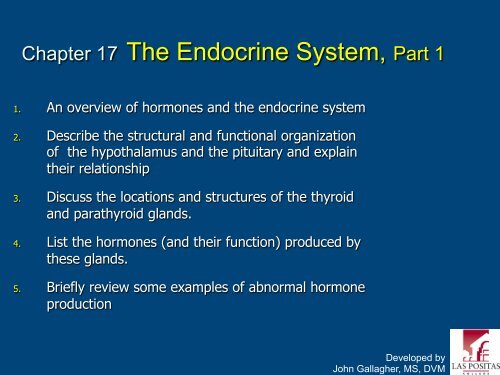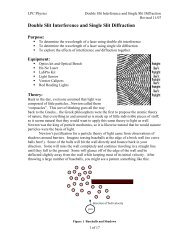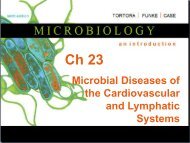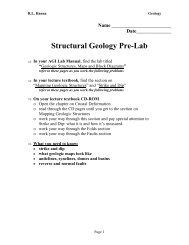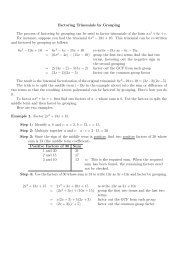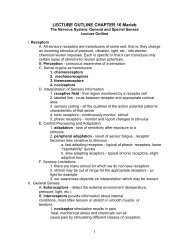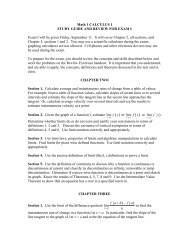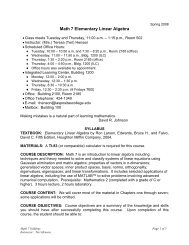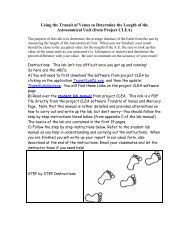Create successful ePaper yourself
Turn your PDF publications into a flip-book with our unique Google optimized e-Paper software.
Developed by<br />
John Gallagher, MS, DVM<br />
<strong>Chapter</strong> <strong>17</strong> <strong>The</strong> <strong>Endocrine</strong> <strong>System</strong>, <strong>Part</strong> 1<br />
1. An overview of hormones and the endocrine system<br />
2. Describe the structural and functional organization<br />
of the hypothalamus and the pituitary and explain<br />
their relationship<br />
3. Discuss the locations and structures of the thyroid<br />
and parathyroid glands.<br />
4. List the hormones (and their function) produced by<br />
these glands.<br />
5. Briefly review some examples of abnormal hormone<br />
production
<strong>Endocrine</strong> <strong>System</strong> Overview<br />
n<br />
n<br />
n<br />
n<br />
Ductless glands produce hormones<br />
Secreted directly into the<br />
bloodstream (endocrine)<br />
n<br />
Except the thyroid<br />
Gland may be entire organ:<br />
n<br />
Pituitary, thyroid, parathyroid, pineal,<br />
adrenal<br />
or bits of tissue interspersed within<br />
an organ<br />
n<br />
Gonads, kidneys, many others<br />
Fig <strong>17</strong>.1
Classes of Hormones (p 516)<br />
n<br />
n<br />
Chemical classification of hormones<br />
n<br />
n<br />
n<br />
Amino Acid Derivatives<br />
n<br />
n<br />
n<br />
Proteins (longer)<br />
Peptides (shorter)<br />
Amines (derived from a single amino<br />
acid)<br />
Steroids (from cholesterol)<br />
n<br />
Glucocorticoids, mineralocorticoids, sex<br />
hormones<br />
Eicosanoids (from arachidonic acid)<br />
Target tissues are identified by<br />
specific receptors (on target cells).<br />
<strong>The</strong> effects may be stimulatory or<br />
inhibitory, depending on the<br />
receptors.
Control of Hormone Secretion<br />
n<br />
n<br />
n<br />
Humoral<br />
n<br />
BP and the kidney’s JG apparatus<br />
Neural<br />
n<br />
n<br />
Recall the adrenal medulla<br />
Hypothalamic Releasing Factors<br />
Hormonal<br />
n<br />
Pituitary Releasing Hormones, e.g., FSH
Hypothalamus<br />
Control Center for<br />
internal<br />
environment<br />
!<br />
!<br />
!<br />
Regulates nervous and endocrine systems via 3<br />
mechanisms:<br />
1. ANS centers exert nervous control on adrenal medulla<br />
Fig <strong>17</strong>.3<br />
2. ADH and Oxytocin production<br />
3. Regulatory hormone production (RH and IH) controls<br />
pituitary gland directly and all other endocrine glands<br />
indirectly<br />
1. <strong>The</strong>se regulatory hormones are released from neurons,<br />
thus we have neuroendocrine cells.
Pituitary Gland (= Hypophysis) p 518<br />
n<br />
n<br />
n<br />
n<br />
n<br />
Structure:<br />
Located at the base of the brain,<br />
surrounded by the Circle of Willis<br />
Infundibulum - connection to<br />
hypothalamus<br />
In the sella turcica of the sphenoid<br />
bone<br />
Two parts with separate embryonic<br />
origins:<br />
n<br />
n<br />
Anterior Pituitary<br />
Posterior Pituitary
Pituitary Gland (= Hypophysis) p 518<br />
• Anterior Pituitary (=<br />
adenohypophysis)<br />
• AKA pars distalis<br />
• production of 7 peptide<br />
hormones<br />
• 4 are tropic hormones,<br />
stimulating other<br />
endocrine glands<br />
• Pars intermedia and pars<br />
tuberalis secrete MSH and<br />
some gonadotropins.<br />
Fig 25.3
Pituitary Gland (= Hypophysis) p 518<br />
• Posterior Pituitary (=<br />
neurohypophysis)<br />
• AKA pars nervosa<br />
• Storage reservoir for ADH<br />
and Oxytocin (produced in )<br />
Fig 25.3
Pituitary Gland (= Hypophysis)<br />
Review<br />
Table 25.1
Anterior Pituitary: Portal <strong>System</strong><br />
n<br />
n<br />
n<br />
Portal systems: two<br />
capillary networks in<br />
serial arrangement<br />
Three sites of capillary<br />
portal systems: liver,<br />
kidney, and pituitary<br />
Portal veins: blood<br />
vessels that link two<br />
capillary networks
Anterior Pituitary: Control<br />
n<br />
n<br />
n<br />
n<br />
n<br />
Hypothalamus has neurons that<br />
produce<br />
n<br />
n<br />
Releasing , e.g., GnRH, or<br />
Inhibiting Hormones<br />
Into the first capillary plexus<br />
Down the infundibulum in portal<br />
veins<br />
Into the second capillary plexus<br />
n<br />
Receptors in pituitary<br />
Hormones then released into the<br />
circulation<br />
Fig <strong>17</strong>.4 (a)
Neurohypophysis = PP<br />
n<br />
n<br />
n<br />
Neurons originate in<br />
the Supraoptic and<br />
Paraventricular Nuclei<br />
<strong>The</strong>ir axons extend<br />
down the infundibulum<br />
Release Oxytocin and<br />
ADH (vasopressin) into<br />
the circulation<br />
Fig <strong>17</strong>.4 (b)
Infundibulum<br />
Anterior Pituitary<br />
Posterior<br />
Pituitary<br />
Superior view
Pituitary MRI,<br />
contrast<br />
enhanced
Thyroid Gland p 523<br />
<br />
<br />
Anterior surface of<br />
trachea just inferior of<br />
thyroid cartilage (or<br />
Adam’s apple)<br />
Two lobes connected by<br />
isthmus<br />
Fig <strong>17</strong>.5
More Thyroid<br />
<br />
Thyroid follicular cells (simple cuboidal<br />
epithelium) produce and store<br />
thyroglobulin in thyroid follicles<br />
<br />
<br />
<br />
Iodine then added to produce thyroxine<br />
(T 4 ) and triiodothyronine (T 3 ) inside the<br />
follicles<br />
<strong>The</strong> thyroglobulin is reabsorbed by the<br />
follicular cells, cleaved, and the thyroid<br />
hormone (T3 and T4) are released into<br />
the bloodstream<br />
Note that this is the only extracellular<br />
storage of hormones<br />
<br />
C (chief) Cells: (AKA parafollicular cells)<br />
produce calcitonin<br />
<br />
n<br />
Interspersed between thyroid follicles<br />
Lower blood Calcium
Classic Negative Feedback Loop
Simple cuboidal<br />
epithelium<br />
C-Cells
Thyroid Disease<br />
n<br />
Hyper-<br />
n<br />
n<br />
Cardiovascular<br />
n Increased BP<br />
n Tachycardia<br />
n Palpitations<br />
Neuromuscular<br />
n Emotional lability<br />
n Insomnia<br />
n<br />
Hypo-<br />
n<br />
n<br />
n<br />
n<br />
n<br />
n<br />
Weakness<br />
Dry, coarse Skin<br />
Lethargy, Slow Speech<br />
Feel cold<br />
Less Sweat<br />
Eyelid and Facial Edema<br />
n Weakness<br />
n Hand Tremor
Parathyroid Glands<br />
4 tiny glands embedded in the posterior aspect of the<br />
thyroid (superior and inferior)<br />
n<br />
n<br />
Parathyroid hormone<br />
(PTH; sometimes also<br />
called parathormone)<br />
Function:<br />
n raises blood [Ca 2+ ]<br />
n<br />
antagonist to Calcitonin


